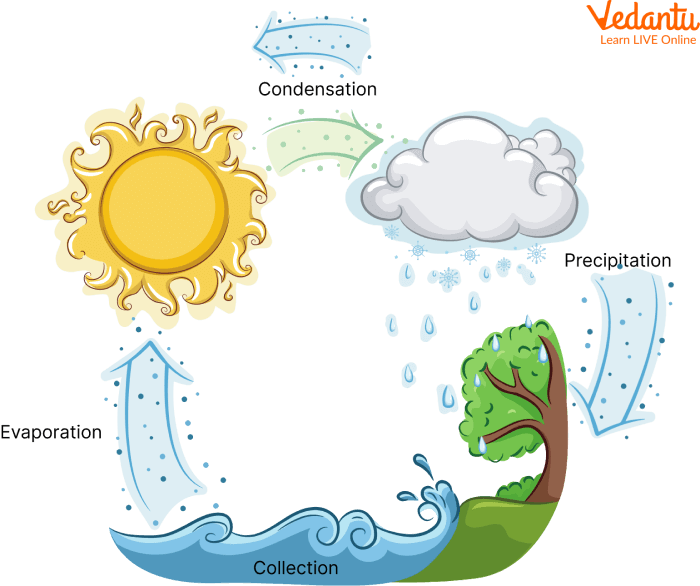




What Are the Main Stages of the Water Cycle?
Throughout the day, water is perhaps the most important thing you need; after your P.E period, during your break, or after playing with your friends- water is usually what you seek to quench your thirst.
But do you ever stop to wonder where your water came from?
Here we will explore where water comes from, the water cycle as well as the process of the water cycle, and its importance.
What is the Water Cycle?
Water is one of the essential natural resources for humans. We use it most in everyday activities, such as cooking, cleaning, and so many more activities. Yet, the water that we use is more than 4 billion years old! The water that we drink today was the same water that the dinosaurs drank, the ancient Romans used and even the same water consumed by many animals worldwide. Water only changes its state from solid to liquid to gas, repeatedly. This process of the continuous movement of water through the earth and atmosphere in various states is known as the Water Cycle (or the Hydrological Cycle).
Water Cycle

Water Cycle Diagram
The Process of the Water Cycle
Water can be found everywhere- in lakes, glaciers, clouds, and yes, even underground! How does the water get there? How does the water from the lake travel to the cloud and then underground?
The Sun heats up the water in various water bodies which evaporate and change to water vapour. This then cools down and condenses, forming clouds where the water falls down to earth as precipitation in the form of- rain, snow, hail, or sleet. The water is collected in ponds, lakes, glaciers, and more, which we use.

Different Forms of Water
The Water Cycle is carried out through four stages: Evaporation, Condensation, Precipitation, and Collection.
Evaporation: This is the “process by which water(liquid) changes to water vapour (gas) due to heat.” In our case, the heat emanated by our Sun heats up the water that is in our lakes, seas, oceans, and various other water bodies, and mixes with the air around us.
Condensation: When the water vapour forms clouds containing water due to cooling, this is known as condensation
Precipitation: When the clouds accumulate too much water, they release their water through precipitation. This happens in different ways such as rain, hail, snow, or sleet depending upon the temperature.
Collection: The water from precipitation is then collected into various water bodies- seas, oceans, lakes, rivers, glaciers, ponds, and underground. This process is also known as “deposition.” The water collected or deposited is then evaporated and the water cycle continues.
The Importance of the Water Cycle
You may wonder, why exactly should we care about this? It happens by itself so how does it affect us and what we do? The Water Cycle is, in fact, very important to us and the survival of not only humans but also many species on this planet.
The water in lakes and rivers is important to us as that is where we get our drinking, cooking, and cleaning water for our basic day-to-day activities.

Uses of Water
The water contained in the soil and underground is also essential as we grow our plants in it, as well as rear different animals that eat these plants.
The water in oceans and seas contains various life forms that contribute to the beautiful diversity of this planet. Sometimes, we even consume some of these organisms, usually fish, crabs, lobsters, and other such organisms.
Summary
The Water Cycle refers to the continuous movement of water through the earth and atmosphere in various states-
The different stages of the Water Cycle are Evaporation, Condensation, Precipitation, and Collection.
The Water Cycle is important to us as we need it for our day-to-day activities. It also serves as the life source for various organisms.
In addition to this, we should also know that our water cycle may be in a precarious situation due to the actions of humans that contribute to global warming and water pollution. We need to come together to preserve the water that has been on this planet for our sake and for all the other organisms that we live with on this planet. The Water Cycle Chart plays an essential and irreplaceable role in the daily lives of all the inhabitants of Earth. We hope that you have learned what the water cycle is, its process, and the importance of water cycle through this.
FAQs on Water Cycle: Definition, Steps, and Facts
1. What is the water cycle in simple terms?
The water cycle is Earth's natural way of recycling water. It describes the continuous movement of water on, above, and below the surface of the Earth. This process ensures that all living things have a constant supply of fresh water.
2. What are the four main stages of the water cycle?
The water cycle has four key stages that happen in a continuous loop:
- Evaporation: The sun heats up water in rivers, lakes, and oceans, turning it into a gas called water vapour, which rises into the air.
- Condensation: As the water vapour rises, it cools down and changes back into tiny liquid water droplets. These droplets come together to form clouds.
- Precipitation: When the clouds get too full of water droplets, they release the water back to Earth in the form of rain, snow, or hail.
- Collection: The water that falls back to Earth is collected in oceans, lakes, and rivers, or it soaks into the ground to become groundwater. The cycle then starts all over again.
3. How do clouds actually form?
Clouds form during the condensation stage. When water evaporates from the ground and water bodies, it rises as invisible water vapour. As this warm, moist air gets higher in the sky, it cools down. The cool temperature causes the water vapour to turn back into millions of tiny liquid water droplets or ice crystals, which group together to become the clouds we can see.
4. If most of Earth's water is in the salty ocean, why is rainwater not salty?
This is a great question! When the sun's heat causes ocean water to evaporate, only the water turns into vapour. The salt is too heavy and gets left behind in the ocean. Because of this, the water that forms clouds and falls back as rain is fresh, not salty.
5. Why is the water cycle so important for life on Earth?
The water cycle is essential for survival. It provides the fresh water that all plants and animals need to drink and grow. It also helps to distribute water all around the planet, creating different weather patterns and climates that support diverse ecosystems, from forests to deserts.
6. What is the difference between evaporation and transpiration?
Both are processes that turn liquid water into water vapour. The main difference is where the water comes from. Evaporation is when water turns to vapour from surfaces like oceans, rivers, and lakes. Transpiration is when plants release water vapour from their leaves into the air.
7. What happens to water that soaks into the ground after it rains?
When rain soaks into the soil, it becomes groundwater. This water is stored in the spaces between rocks and soil particles underground. Groundwater is an important source of drinking water for many people, often accessed through wells. It can also slowly flow back into rivers and lakes to continue the cycle.
8. Can you give a simple example of the water cycle I can see at home?
Yes! You can see a mini water cycle when you boil water in a kettle. The boiling water turns into steam (evaporation). If you hold a cool metal lid above the steam, you'll see water droplets form on it (condensation). If enough droplets gather, they will drip off the lid like rain (precipitation).









